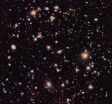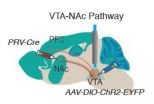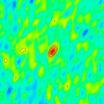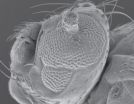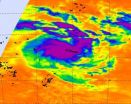(Press-News.org) PASADENA, Calif.—A team of astronomers led by the California Institute of Technology (Caltech) has used NASA's Hubble Space Telescope to discover seven of the most primitive and distant galaxies ever seen.
One of the galaxies, the astronomers say, might be the all-time record holder—the galaxy as observed existed when the universe was merely 380 million years old. All of the newly discovered galaxies formed more than 13 billion years ago, when the universe was just about 4 percent of its present age, a period astronomers call the "cosmic dawn," when the first galaxies were born. The universe is now 13.7 billion years old.
The new observations span a period between 350 million and 600 million years after the Big Bang and represent the first reliable census of galaxies at such an early time in cosmic history, the team says. The astronomers found that the number of galaxies steadily increased as time went on, supporting the idea that the first galaxies didn't form in a sudden burst but gradually assembled their stars.
Because it takes light billions of years to travel such vast distances, astronomical images show how the universe looked during the period, billions of years ago, when that light first embarked on its journey. The farther away astronomers peer into space, the further back in time they are looking.
In the new study, which was recently accepted for publication in the Astrophysical Journal Letters, the team has explored the deepest reaches of the cosmos—and therefore the most distant past—that has ever been studied with Hubble.
"We've made the longest exposure that Hubble has ever taken, capturing some of the faintest and most distant galaxies," says Richard Ellis, the Steele Family Professor of Astronomy at Caltech and the first author of the paper. "The added depth and our carefully designed observing strategy have been the key features of our campaign to reliably probe this early period of cosmic history."
The results are the first from a new Hubble survey that focused on a small patch of sky known as the Hubble Ultra Deep Field (HUDF), which was first studied nine years ago. The astronomers used Hubble's Wide Field Camera 3 (WFC3) to observe the HUDF in near-infrared light over a period of six weeks during August and September 2012.
To determine the distances to these galaxies, the team measured their colors using four filters that allow Hubble to capture near-infrared light at specific wavelengths. "We employed a filter that has not been used in deep imaging before, and undertook much deeper exposures in some filters than in earlier work, in order to convincingly reject the possibility that some of our galaxies might be foreground objects," says team member James Dunlop of the Institute for Astronomy at the University of Edinburgh.
The carefully chosen filters allowed the astronomers to measure the light that was absorbed by neutral hydrogen, which filled the universe beginning about 400,000 years after the Big Bang. Stars and galaxies started to form roughly 200 million years after the Big Bang. As they did, they bathed the cosmos with ultraviolet light, which ionized the neutral hydrogen by stripping an electron from each hydrogen atom. This so-called "epoch of reionization" lasted until the universe was about a billion years old.
If everything in the universe were stationary, astronomers would see that only a specific wavelength of light was absorbed by neutral hydrogen. But the universe is expanding, and this stretches the wavelengths of light coming from galaxies. The amount that the light is stretched—called the redshift—depends on distance: the farther away a galaxy is, the greater the redshift.
As a result of this cosmic expansion, astronomers observe that the absorption of light by neutral hydrogen occurs at longer wavelengths for more distant galaxies. The filters enabled the researchers to determine at which wavelength the light was absorbed; this revealed the distance to the galaxy—and therefore the period in cosmic history when it is being formed. Using this technique to penetrate further and further back in time, the team found a steadily decreasing number of galaxies.
"Our data confirms that reionization is a drawn-out process occurring over several hundred million years with galaxies slowly building up their stars and chemical elements," says coauthor Brant Robertson of the University of Arizona in Tucson. "There wasn't a single dramatic moment when galaxies formed; it's a gradual process."
The new observations—which pushed Hubble to its technical limits—hint at what is to come with next-generation infrared space telescopes, the researchers say. To probe even further back in time to see ever more primitive galaxies, astronomers will need to observe in wavelengths longer than those that can be detected by Hubble. That's because cosmic expansion has stretched the light from the most distant galaxies so much that they glow predominantly in the infrared. The upcoming James Webb Space Telescope, slated for launch in a few years, will target those galaxies.
"Although we may have reached back as far as Hubble will see, Hubble has, in a sense, set the stage for Webb," says team member Anton Koekemoer of the Space Telescope Science Institute in Baltimore. "Our work indicates there is a rich field of even earlier galaxies that Webb will be able to study."
INFORMATION:
The title of the Astrophysical Journal Letters paper is, "The Abundance of Star-Forming Galaxies in the Redshift Range 8.5 to 12: New Results from the 2012 Hubble Ultra Deep Field Campaign." In addition to Ellis, Dunlop, Robertson, and Koekemoer, the other authors on the Astrophysical Journal Letters paper are Matthew Schenker of Caltech; Ross McLure, Rebecca Bowler, Alexander Rogers, Emma Curtis-Lake, and Michele Cirasuolo of the Institute for Astronomy at the University of Edinburgh; Yoshiaki Ono and Masami Ouchi of the University of Tokyo; Evan Schneider of the University of Arizona; Daniel Stark of the University of Cambridge; Stéphane Charlot of the Institut d'Astrophysique de Paris; and Steven Furlanetto of UCLA. The research was supported by the Space Telescope Science Institute, the European Research Council, the Royal Society, and the Leverhulme Trust.
Written by Marcus Woo
Caltech Science Contacts:
Richard Ellis, Steele Professor of Astronomy
rse@astro.caltech.edu
(626) 676-5530
Matt Schenker, graduate student
schenker@astro.caltech.edu
(516) 428-0587
Caltech-led astronomers discover galaxies near cosmic dawn
Researchers conduct first census of the most primitive and distant galaxies seen
2012-12-13
ELSE PRESS RELEASES FROM THIS DATE:
NASA'S Hubble provides first census of galaxies near cosmic dawn
2012-12-13
WASHINGTON -- Using NASA's Hubble Space Telescope, astronomers have uncovered a previously unseen population of seven primitive galaxies that formed more than 13 billion years ago, when the universe was less than 4 percent of its present age. The deepest images to date from Hubble yield the first statistically robust sample of galaxies that tells how abundant they were close to the era when galaxies first formed.
The results are from an ambitious Hubble survey of an intensively studied patch of sky known as the Ultra Deep Field (UDF). In the 2012 campaign, called UDF12, ...
Building better barley
2012-12-13
As one of the top 10 barley producers in the world, Canada faces a problem of adapting to the 'new normal' of a warmer, drier climate.
The 2012 growing season was considered an average year on the Canadian Prairies, "but we still had a summer water deficit, and it is that type of condition we are trying to work with," said Scott Chang, a professor of soil science in the University of Alberta's Department of Renewable Resources in Edmonton, Canada.
Chang teamed with fellow crop scientist Anthony Anyia of Alberta Innovates – Technology Futures in 2006, following a severe ...
Mercyhurst University study probes impact of climate change on ectotherms
2012-12-13
A new study by biologists at Mercyhurst University focuses on the influence of climate change, particularly warmer winters, on the survival and potential fecundity of cold-blooded animals.
Cold blooded animals, or ectotherms, do not have an internal mechanism for regulating body temperature. Instead, they rely on solar energy captured by the environment.
The purpose of the Mercyhurst study, a collaboration of Michael Elnitsky, Ph.D., assistant professor of biology; and students Drew Spacht and Seth Pezar, is to assess the current and future impacts of climate change ...
Stress-resilience/susceptibility traced to neurons in reward circuit
2012-12-13
A specific pattern of neuronal firing in a brain reward circuit instantly rendered mice vulnerable to depression-like behavior induced by acute severe stress, a study supported by the National Institutes of Health has found. When researchers used a high-tech method to mimic the pattern, previously resilient mice instantly succumbed to a depression-like syndrome of social withdrawal and reduced pleasure-seeking – they avoided other animals and lost their sweet tooth. When the firing pattern was inhibited in vulnerable mice, they instantly became resilient.
"For the first ...
Astronomers catch jet from binge-eating black hole
2012-12-13
Back in January, a new X-ray source flared and rapidly brightened in the Andromeda galaxy (M31), located 2.5 million light-years away. Classified as an ultraluminous X-ray source (ULX), the object is only the second ever seen in M31 and became the target of an intense observing campaign by orbiting X-ray telescopes -- including NASA's Swift -- and radio observatories on the ground. These efforts resulted in the first detection of radio-emitting jets from a stellar-mass black hole outside our own galaxy.
A ULX is thought to be a binary system containing a black hole that ...
Protein strongest just before death
2012-12-13
Researchers at Michigan State University have discovered a protein that does its best work with one foot in the grave.
The study, which appears in the current issue of the Journal of Biological Chemistry, focuses on the nontraditional lifestyle of Retinoblastoma tumor suppressor proteins, which could lead to new ways to treat cancer.
"Retinoblastoma proteins are unique in that they use controlled destruction to do their jobs in a timely but restrained fashion," said Liang Zhang, a lead author and MSU cell and molecular biology graduate student. "This is an unusual way ...
Experimental agent briefly eases depression rapidly in test
2012-12-13
A drug that works through the same brain mechanism as the fast-acting antidepressant ketamine briefly improved treatment-resistant patients' depression symptoms in minutes, with minimal untoward side effects, in a clinical trial conducted by the National Institutes of Health. The experimental agent, called AZD6765, acts through the brain's glutamate chemical messenger system.
Existing antidepressants available through prescription, which work through the brain's serotonin system, take a few weeks to work, imperiling severely depressed patients, who can be at high risk ...
Study reveals new factor that could limit the life of hybrid and electric car batteries
2012-12-13
COLUMBUS, Ohio – A new study of the batteries commonly used in hybrid and electric-only cars has revealed an unexpected factor that could limit the performance of batteries currently on the road.
Researchers led by Ohio State University engineers examined used car batteries and discovered that over time lithium accumulates beyond the battery electrodes – in the "current collector," a sheet of copper which facilitates electron transfer between the electrodes and the car's electrical system.
This knowledge could aid in improving design and performance of batteries, explained ...
NASA sees newborn Tropical Storm Evan causing trouble for American Samoa
2012-12-13
The date 12-12-12 may be numerically significant, but for the residents of American Samoa and Fiji in the South Pacific Ocean, it means a newborn tropical storm named Evan is causing problems. NASA's Aqua satellite and NOAA's GOES-15 satellite both captured imagery of the newborn storm's cloud cover.
Tropical Storm Evan caused regional warnings to be posted on Dec. 12. In American Samoa, a gale warning and storm watch are in effect for Tutuila, Aunuu, Manua and Swains Island.
The Atmospheric Infrared Sounder (AIRS) instrument aboard NASA's Aqua satellite captured an ...
Ceramic indoor cookstove use did not significantly lower child pneumonia risk in rural Kenya
2012-12-13
DEERFIELD, Il. (December 11, 2012)—Inexpensive, locally-produced ceramic cookstoves may produce less smoke than traditional indoor 3-stone firepits, but they don't significantly reduce indoor air pollution or the risk of pneumonia in young children, according to results from a small, year-long observational study by researchers working in rural Kenya.
The findings, published online today in the American Journal of Tropical Medicine and Hygiene, are the first to examine the health impacts of ceramic cookstoves that do not vent smoke to the outside of the house, said Robert ...
LAST 30 PRESS RELEASES:
Norbert Holtkamp appointed director of Fermi National Accelerator Laboratory
New agentic AI platform accelerates advanced optics design
Biologists discover neurons use physical signals — not electricity — to stabilize communication
Researchers discover that a hormone can access the brain by hitchhiking
University of Oklahoma researcher awarded funding to pursue AI-powered material design
Exploring how the visual system recovers following injury
Support for parents with infants at pediatric check-ups leads to better reading and math skills in elementary school
Kids’ behavioral health is a growing share of family health costs
Day & night: Cancer disrupts the brain’s natural rhythm
COVID-19 vaccination significantly reduces risk to pregnant women and baby
The role of vaccination in maternal and perinatal outcomes associated with COVID-19 in pregnancy
Mayo Clinic smartwatch system helps parents shorten and defuse children's severe tantrums early
Behavioral health spending spikes to 40% of all children’s health expenditures, nearly doubling in a decade
Digital cognitive behavioral treatment for generalized anxiety disorder
Expenditures for pediatric behavioral health care over time and estimated family financial burden
Air conditioning in nursing homes and mortality during extreme heat
The Alps to lose a record number of glaciers in the next decade
What makes a good proton conductor?
New science reporting guide published for journalists in Bulgaria
New international study reveals major survival gaps among children with cancer
New science reporting guide published for journalists in Turkey
Scientists develop a smarter mRNA therapy that knows which cells to target
Neuroanatomy-informed brain–machine hybrid intelligence for robust acoustic target detection
Eight SwRI hydrogen projects funded by ENERGYWERX
The Lundquist Institute and its start-up company Vitalex Biosciences Announces Strategic Advancement of Second-Generation fungal Vaccine VXV-01 through Phase 1 Trials under $40 Million Competitive Con
Fine particles in pollution are associated with early signs of autoimmune disease
Review article | Towards a Global Ground-Based Earth Observatory (GGBEO): Leveraging existing systems and networks
Penn and UMich create world’s smallest programmable, autonomous robots
Cleveland researchers launch first major study to address ‘hidden performance killer’ in athletes
To connect across politics, try saying what you oppose
[Press-News.org] Caltech-led astronomers discover galaxies near cosmic dawnResearchers conduct first census of the most primitive and distant galaxies seen
